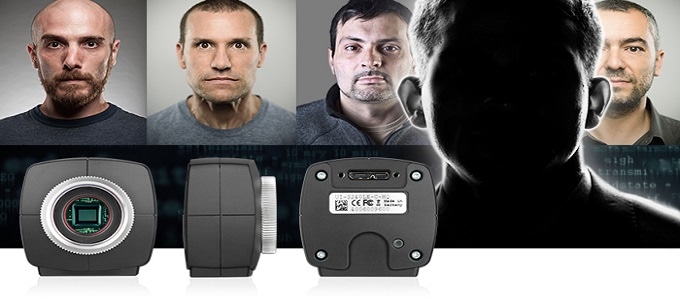
British company Acumé Forensic is renowned for its evidential identification services, which are used to help solve a wide range of crimes from fraud to armed robbery and murder. Reliable identification of potential perpetrators is crucial in solving these cases.
The identification process traditionally relies on custody imaging (mug shots) or CCTV footage, and is often hampered due to poor image quality. If the images are blurred or indistinct, even the police will have a very hard time identifying a suspect.
To complicate matters further, the person whose image is recorded doesn't look directly at the camera in most cases. And, for forensic experts like the team at Acumé Forensic, poor-quality source material leads to frustration. That's why this Leeds-based company worked with the University of Bradford to develop a pioneering technology for unambiguous identification, with the ultimate aim of fighting crime.
Application

The system developed by the forensic experts will even enable police officers on the beat to generate clear and unambiguous source material for potential identification. According to guidance issued by the British Home Office, police officers should capture at least five images of every person taken into custody. The better the quality of these images, the easier it will be to compare these later with image and video evidence relating to criminal acts. This inspired the idea to develop “HALO”, a forensic system for biometric identification of potential suspects.
Each “HALO” system is equipped with four USB 3 uEye LE machine vision cameras from IDS Imaging Development Systems GmbH. These particularly powerful CMOS cameras deliver the five required photographs of potential perpetrators from different angles in a single step with a level of quality that far surpasses the current standard.

The system simultaneously uses software developed by Acumé Forensic to capture biometric facial data – unique to every individual – together with each image recorded. The algorithm used is capable of differentiating between more than 1 million features of a human face. The information captured includes details of skin color and texture and the shape of the eyes, ears, nose and mouth.
The system also detects color variations in the skin on an individual's face, as well as the physical dimensions of the various features and statistical deviations, such as how much the face varies from an average face. HALO creates a record of the person's unique facial features, so that they can subsequently be identified even if only the tiniest part of their face is visible.
The 18 megapixel sensor in the USB 3.0 camera ensures that no detail is missed. As a result, distinctive features can be highlighted, making information contained in an image, or even an incomplete image, as valuable as a fingerprint. A 3D model of the face is generated, enabling an unprecedented standard of quality in the field of automatic identification.

As a result, images of suspects taken from CCTV footage can be used for identification even if the quality is poor or the individual is not looking directly at the camera. "Once our algorithm has learned a face, it can recognize them even from just their ear”, explains Professor Hassan Ugail, Professor for Visual Computing at the University of Bradford, who is involved in developing the system.
Camera

To improve the chances of criminals being tracked down using facial identification, the Acumé Forensic team led by system developer Peter Lowery integrated a UI-3580LE-C-HQ color camera with a 5 MP CMOS sensor from ON Semiconductor, plus three UI-3590LE-C-HQ cameras into their HALO system.
These three cameras are equipped with a CMOS color sensor from ON Semiconductor, which ensures richly detailed images – from VGA, through 4K cinema, to full 18 MP resolution. BSI (back side illuminated) pixel technology ensures high-level light sensitivity, making this sensor ideal for high-resolution visualization tasks.
The criminal investigators were also impressed by the compact housing of the USB 3 uEye LE camera, with its miniature dimensions of 47 x 46 x 26.3 mm. The cost-effective, space-saving project camera is suitable for a broad range of uses, not least thanks to its C/CS-mount lens mount, which also enables the use of wide-angle lenses.
The forensic experts also conducted a thorough investigation of the IDS camera's compatibility. The many illustrative sample programs provided in the DS Software Development Kit helped these super-sleuths to track down the right camera supplier. Thanks to the IDS Software Suite's .NET interface, the USB machine vision cameras were easily integrated into Acumé's application.
The greatest benefits offered by IDS are the wide product range, an extensive software package and excellent support
Peter Lowery
Outlook – Sherlock Holmes and Dr. Watson
The USB 3 uEye LE is to HALO what Dr. Watson is to Sherlock Holmes. Working together, they are an invincible crime-solving team. After the high-resolution photos have been taken and the biometric data captured, these are initially stored on a local server, from which they are subsequently made available in a national police database. This allows the person to be identified and matched to a record in the database at a later point in time and, more importantly, at a national rather than merely local level.
The HALO system is soon to be installed by the University of Bradford in conjunction with Leicestershire Police.
The project also involves integrating databases from police forces across the country, many of which have different operating systems, meaning that our software can access all these databases quickly in order to identify someone.
Professor Ugail.
So, in the future, it will be possible to use HALOs with IDS machine vision cameras to solve a range of different criminal cases – that's bad news for the bad guys!